Evaluating Research Literacy: Public Health, Ethics, and Appraisal
VerifiedAdded on 2023/06/06
|20
|3600
|219
Report
AI Summary
This report examines the implications of research literacy in public health practice, focusing on critical appraisal and ethical considerations. It uses the CASP tool to evaluate both qualitative and quantitative studies. The qualitative study explores the experiences of multiple stakeholders in mental health recovery, providing valuable insights. The quantitative study reveals improvements needed in evidence-informed decision-making (EIDM) among health service managers, highlighting systematic changes. The report also addresses the ethical issues relevant to the discussed studies, emphasizing the importance of considering the relationship between researchers and participants and adhering to ethical guidelines for research conduct. Desklib provides students access to a wealth of solved assignments and study resources.
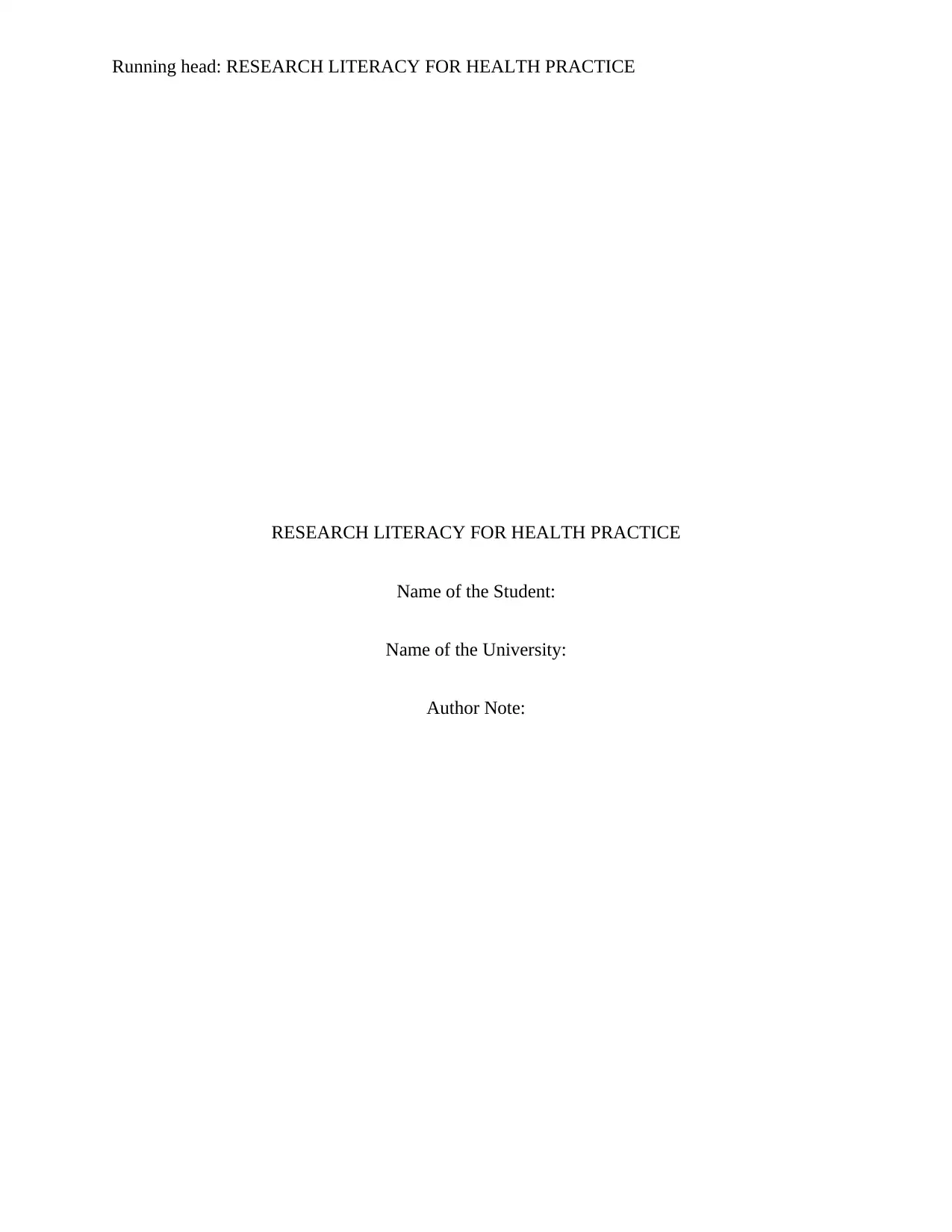
Running head: RESEARCH LITERACY FOR HEALTH PRACTICE
RESEARCH LITERACY FOR HEALTH PRACTICE
Name of the Student:
Name of the University:
Author Note:
RESEARCH LITERACY FOR HEALTH PRACTICE
Name of the Student:
Name of the University:
Author Note:
Paraphrase This Document
Need a fresh take? Get an instant paraphrase of this document with our AI Paraphraser
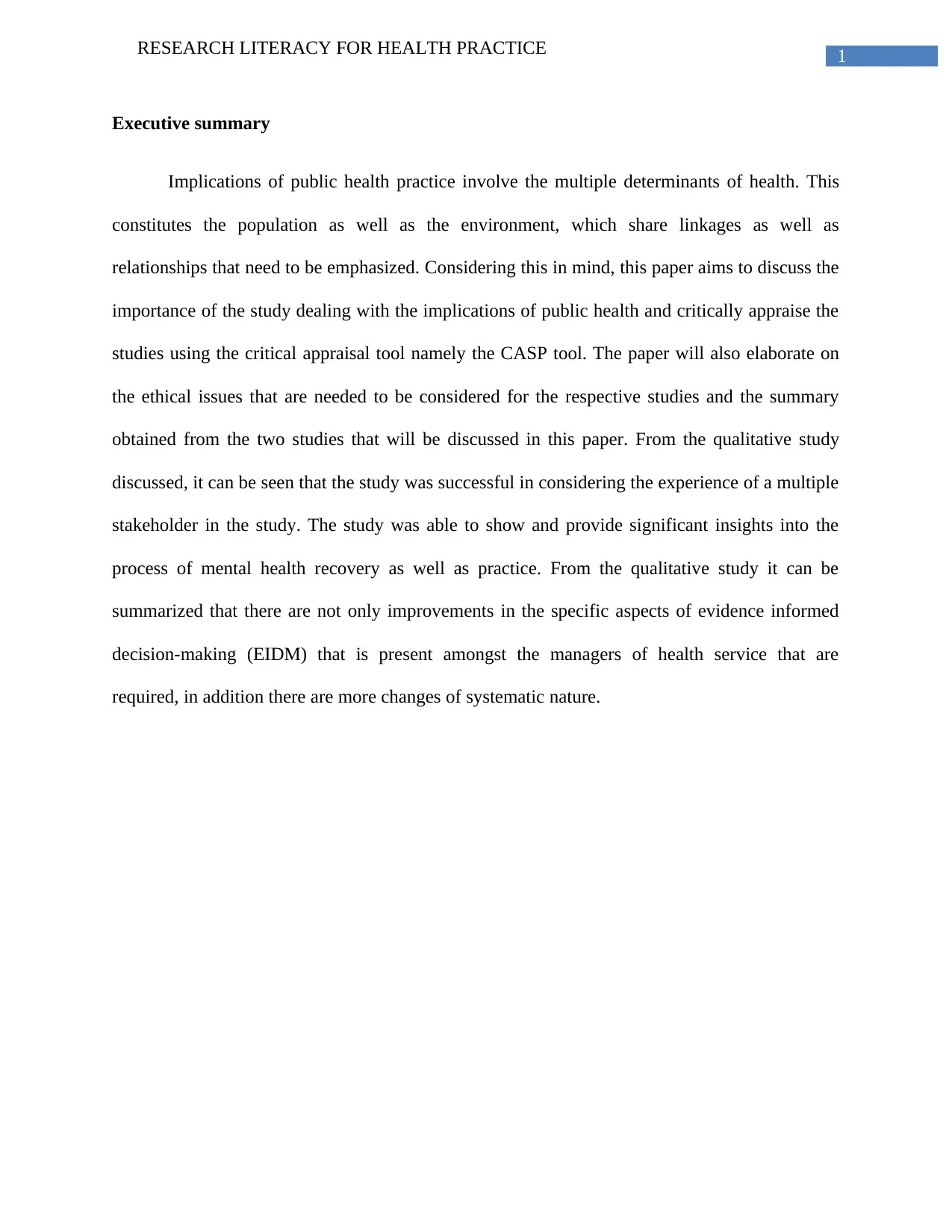
1RESEARCH LITERACY FOR HEALTH PRACTICE
Executive summary
Implications of public health practice involve the multiple determinants of health. This
constitutes the population as well as the environment, which share linkages as well as
relationships that need to be emphasized. Considering this in mind, this paper aims to discuss the
importance of the study dealing with the implications of public health and critically appraise the
studies using the critical appraisal tool namely the CASP tool. The paper will also elaborate on
the ethical issues that are needed to be considered for the respective studies and the summary
obtained from the two studies that will be discussed in this paper. From the qualitative study
discussed, it can be seen that the study was successful in considering the experience of a multiple
stakeholder in the study. The study was able to show and provide significant insights into the
process of mental health recovery as well as practice. From the qualitative study it can be
summarized that there are not only improvements in the specific aspects of evidence informed
decision-making (EIDM) that is present amongst the managers of health service that are
required, in addition there are more changes of systematic nature.
Executive summary
Implications of public health practice involve the multiple determinants of health. This
constitutes the population as well as the environment, which share linkages as well as
relationships that need to be emphasized. Considering this in mind, this paper aims to discuss the
importance of the study dealing with the implications of public health and critically appraise the
studies using the critical appraisal tool namely the CASP tool. The paper will also elaborate on
the ethical issues that are needed to be considered for the respective studies and the summary
obtained from the two studies that will be discussed in this paper. From the qualitative study
discussed, it can be seen that the study was successful in considering the experience of a multiple
stakeholder in the study. The study was able to show and provide significant insights into the
process of mental health recovery as well as practice. From the qualitative study it can be
summarized that there are not only improvements in the specific aspects of evidence informed
decision-making (EIDM) that is present amongst the managers of health service that are
required, in addition there are more changes of systematic nature.
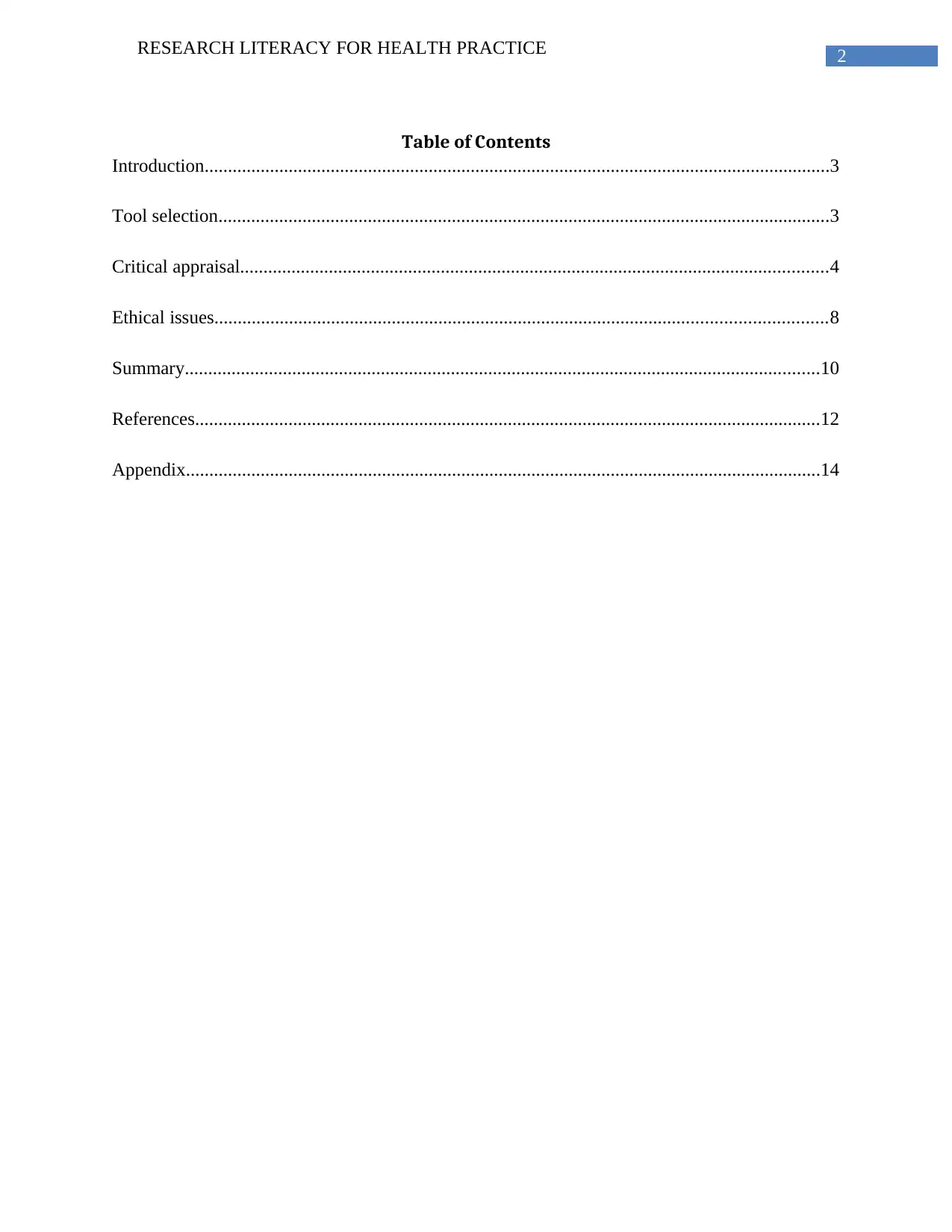
2RESEARCH LITERACY FOR HEALTH PRACTICE
Table of Contents
Introduction......................................................................................................................................3
Tool selection...................................................................................................................................3
Critical appraisal..............................................................................................................................4
Ethical issues...................................................................................................................................8
Summary........................................................................................................................................10
References......................................................................................................................................12
Appendix........................................................................................................................................14
Table of Contents
Introduction......................................................................................................................................3
Tool selection...................................................................................................................................3
Critical appraisal..............................................................................................................................4
Ethical issues...................................................................................................................................8
Summary........................................................................................................................................10
References......................................................................................................................................12
Appendix........................................................................................................................................14
⊘ This is a preview!⊘
Do you want full access?
Subscribe today to unlock all pages.

Trusted by 1+ million students worldwide
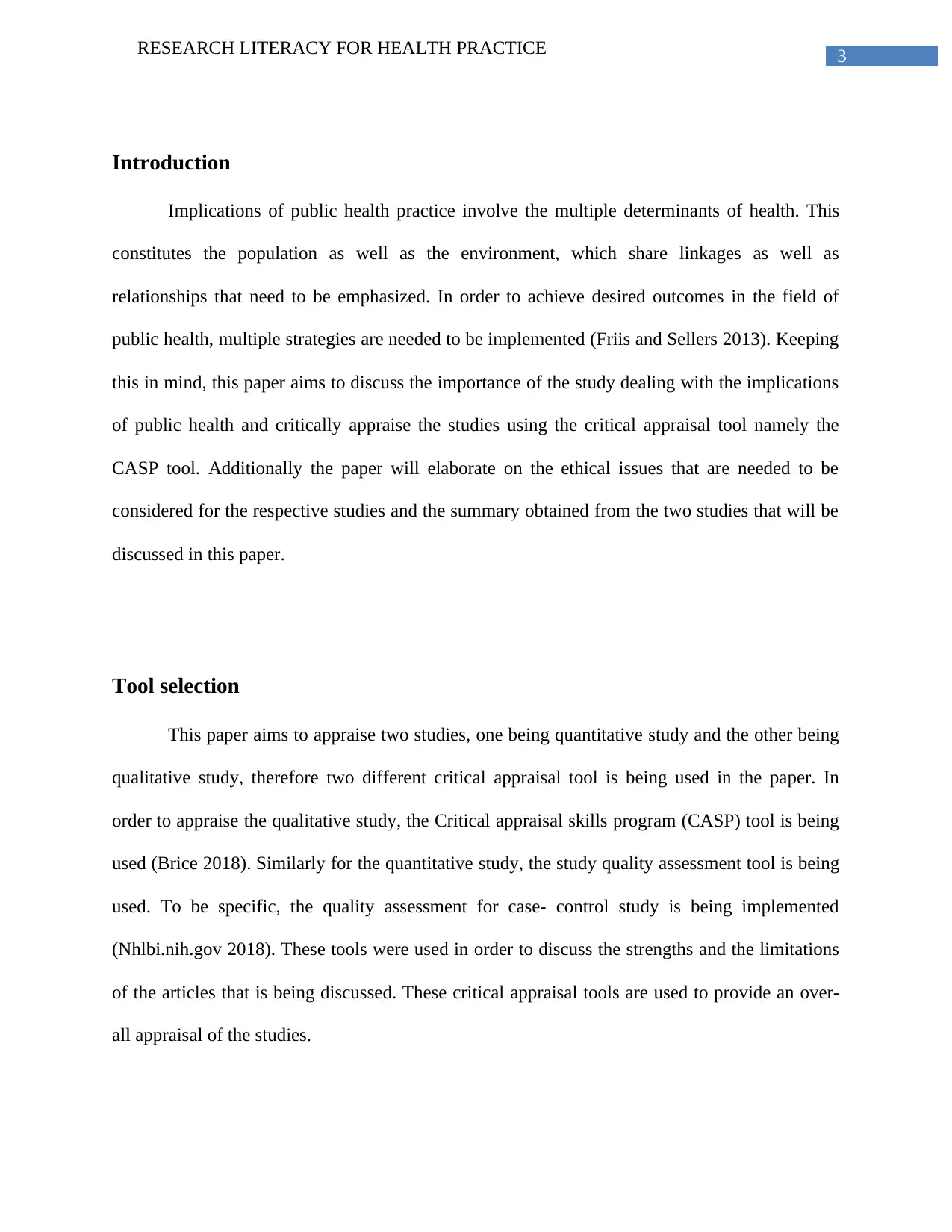
3RESEARCH LITERACY FOR HEALTH PRACTICE
Introduction
Implications of public health practice involve the multiple determinants of health. This
constitutes the population as well as the environment, which share linkages as well as
relationships that need to be emphasized. In order to achieve desired outcomes in the field of
public health, multiple strategies are needed to be implemented (Friis and Sellers 2013). Keeping
this in mind, this paper aims to discuss the importance of the study dealing with the implications
of public health and critically appraise the studies using the critical appraisal tool namely the
CASP tool. Additionally the paper will elaborate on the ethical issues that are needed to be
considered for the respective studies and the summary obtained from the two studies that will be
discussed in this paper.
Tool selection
This paper aims to appraise two studies, one being quantitative study and the other being
qualitative study, therefore two different critical appraisal tool is being used in the paper. In
order to appraise the qualitative study, the Critical appraisal skills program (CASP) tool is being
used (Brice 2018). Similarly for the quantitative study, the study quality assessment tool is being
used. To be specific, the quality assessment for case- control study is being implemented
(Nhlbi.nih.gov 2018). These tools were used in order to discuss the strengths and the limitations
of the articles that is being discussed. These critical appraisal tools are used to provide an over-
all appraisal of the studies.
Introduction
Implications of public health practice involve the multiple determinants of health. This
constitutes the population as well as the environment, which share linkages as well as
relationships that need to be emphasized. In order to achieve desired outcomes in the field of
public health, multiple strategies are needed to be implemented (Friis and Sellers 2013). Keeping
this in mind, this paper aims to discuss the importance of the study dealing with the implications
of public health and critically appraise the studies using the critical appraisal tool namely the
CASP tool. Additionally the paper will elaborate on the ethical issues that are needed to be
considered for the respective studies and the summary obtained from the two studies that will be
discussed in this paper.
Tool selection
This paper aims to appraise two studies, one being quantitative study and the other being
qualitative study, therefore two different critical appraisal tool is being used in the paper. In
order to appraise the qualitative study, the Critical appraisal skills program (CASP) tool is being
used (Brice 2018). Similarly for the quantitative study, the study quality assessment tool is being
used. To be specific, the quality assessment for case- control study is being implemented
(Nhlbi.nih.gov 2018). These tools were used in order to discuss the strengths and the limitations
of the articles that is being discussed. These critical appraisal tools are used to provide an over-
all appraisal of the studies.
Paraphrase This Document
Need a fresh take? Get an instant paraphrase of this document with our AI Paraphraser
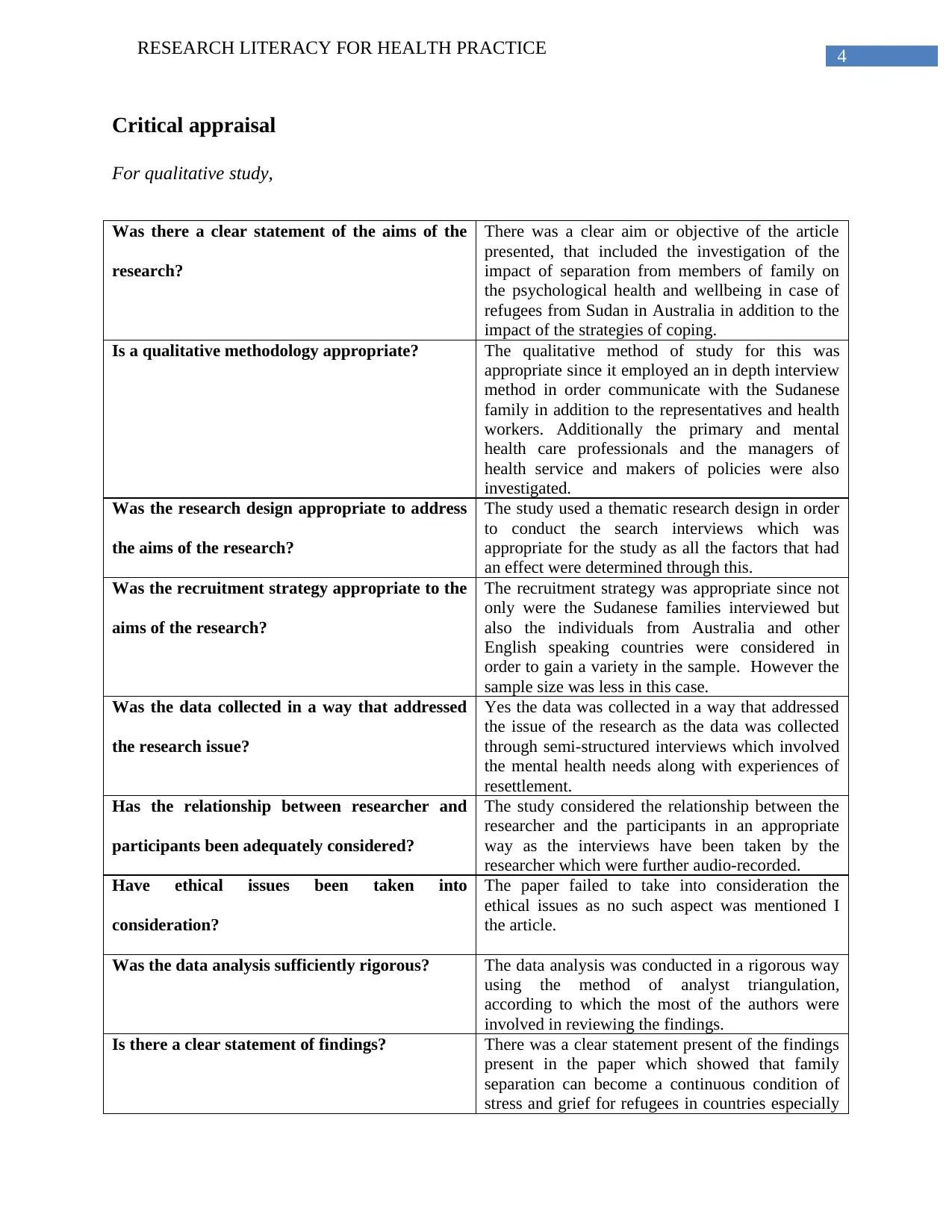
4RESEARCH LITERACY FOR HEALTH PRACTICE
Critical appraisal
For qualitative study,
Was there a clear statement of the aims of the
research?
There was a clear aim or objective of the article
presented, that included the investigation of the
impact of separation from members of family on
the psychological health and wellbeing in case of
refugees from Sudan in Australia in addition to the
impact of the strategies of coping.
Is a qualitative methodology appropriate? The qualitative method of study for this was
appropriate since it employed an in depth interview
method in order communicate with the Sudanese
family in addition to the representatives and health
workers. Additionally the primary and mental
health care professionals and the managers of
health service and makers of policies were also
investigated.
Was the research design appropriate to address
the aims of the research?
The study used a thematic research design in order
to conduct the search interviews which was
appropriate for the study as all the factors that had
an effect were determined through this.
Was the recruitment strategy appropriate to the
aims of the research?
The recruitment strategy was appropriate since not
only were the Sudanese families interviewed but
also the individuals from Australia and other
English speaking countries were considered in
order to gain a variety in the sample. However the
sample size was less in this case.
Was the data collected in a way that addressed
the research issue?
Yes the data was collected in a way that addressed
the issue of the research as the data was collected
through semi-structured interviews which involved
the mental health needs along with experiences of
resettlement.
Has the relationship between researcher and
participants been adequately considered?
The study considered the relationship between the
researcher and the participants in an appropriate
way as the interviews have been taken by the
researcher which were further audio-recorded.
Have ethical issues been taken into
consideration?
The paper failed to take into consideration the
ethical issues as no such aspect was mentioned I
the article.
Was the data analysis sufficiently rigorous? The data analysis was conducted in a rigorous way
using the method of analyst triangulation,
according to which the most of the authors were
involved in reviewing the findings.
Is there a clear statement of findings? There was a clear statement present of the findings
present in the paper which showed that family
separation can become a continuous condition of
stress and grief for refugees in countries especially
Critical appraisal
For qualitative study,
Was there a clear statement of the aims of the
research?
There was a clear aim or objective of the article
presented, that included the investigation of the
impact of separation from members of family on
the psychological health and wellbeing in case of
refugees from Sudan in Australia in addition to the
impact of the strategies of coping.
Is a qualitative methodology appropriate? The qualitative method of study for this was
appropriate since it employed an in depth interview
method in order communicate with the Sudanese
family in addition to the representatives and health
workers. Additionally the primary and mental
health care professionals and the managers of
health service and makers of policies were also
investigated.
Was the research design appropriate to address
the aims of the research?
The study used a thematic research design in order
to conduct the search interviews which was
appropriate for the study as all the factors that had
an effect were determined through this.
Was the recruitment strategy appropriate to the
aims of the research?
The recruitment strategy was appropriate since not
only were the Sudanese families interviewed but
also the individuals from Australia and other
English speaking countries were considered in
order to gain a variety in the sample. However the
sample size was less in this case.
Was the data collected in a way that addressed
the research issue?
Yes the data was collected in a way that addressed
the issue of the research as the data was collected
through semi-structured interviews which involved
the mental health needs along with experiences of
resettlement.
Has the relationship between researcher and
participants been adequately considered?
The study considered the relationship between the
researcher and the participants in an appropriate
way as the interviews have been taken by the
researcher which were further audio-recorded.
Have ethical issues been taken into
consideration?
The paper failed to take into consideration the
ethical issues as no such aspect was mentioned I
the article.
Was the data analysis sufficiently rigorous? The data analysis was conducted in a rigorous way
using the method of analyst triangulation,
according to which the most of the authors were
involved in reviewing the findings.
Is there a clear statement of findings? There was a clear statement present of the findings
present in the paper which showed that family
separation can become a continuous condition of
stress and grief for refugees in countries especially
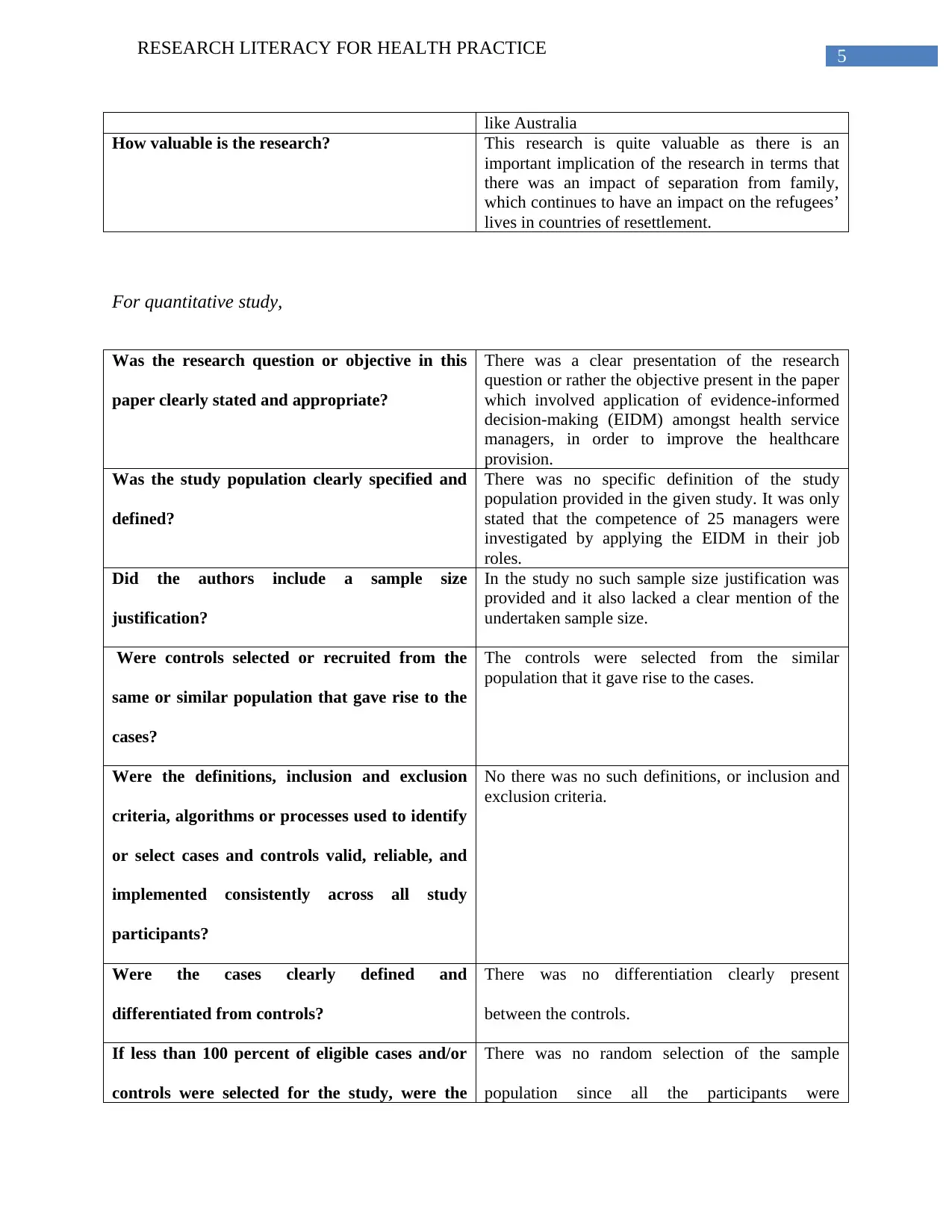
5RESEARCH LITERACY FOR HEALTH PRACTICE
like Australia
How valuable is the research? This research is quite valuable as there is an
important implication of the research in terms that
there was an impact of separation from family,
which continues to have an impact on the refugees’
lives in countries of resettlement.
For quantitative study,
Was the research question or objective in this
paper clearly stated and appropriate?
There was a clear presentation of the research
question or rather the objective present in the paper
which involved application of evidence-informed
decision-making (EIDM) amongst health service
managers, in order to improve the healthcare
provision.
Was the study population clearly specified and
defined?
There was no specific definition of the study
population provided in the given study. It was only
stated that the competence of 25 managers were
investigated by applying the EIDM in their job
roles.
Did the authors include a sample size
justification?
In the study no such sample size justification was
provided and it also lacked a clear mention of the
undertaken sample size.
Were controls selected or recruited from the
same or similar population that gave rise to the
cases?
The controls were selected from the similar
population that it gave rise to the cases.
Were the definitions, inclusion and exclusion
criteria, algorithms or processes used to identify
or select cases and controls valid, reliable, and
implemented consistently across all study
participants?
No there was no such definitions, or inclusion and
exclusion criteria.
Were the cases clearly defined and
differentiated from controls?
There was no differentiation clearly present
between the controls.
If less than 100 percent of eligible cases and/or
controls were selected for the study, were the
There was no random selection of the sample
population since all the participants were
like Australia
How valuable is the research? This research is quite valuable as there is an
important implication of the research in terms that
there was an impact of separation from family,
which continues to have an impact on the refugees’
lives in countries of resettlement.
For quantitative study,
Was the research question or objective in this
paper clearly stated and appropriate?
There was a clear presentation of the research
question or rather the objective present in the paper
which involved application of evidence-informed
decision-making (EIDM) amongst health service
managers, in order to improve the healthcare
provision.
Was the study population clearly specified and
defined?
There was no specific definition of the study
population provided in the given study. It was only
stated that the competence of 25 managers were
investigated by applying the EIDM in their job
roles.
Did the authors include a sample size
justification?
In the study no such sample size justification was
provided and it also lacked a clear mention of the
undertaken sample size.
Were controls selected or recruited from the
same or similar population that gave rise to the
cases?
The controls were selected from the similar
population that it gave rise to the cases.
Were the definitions, inclusion and exclusion
criteria, algorithms or processes used to identify
or select cases and controls valid, reliable, and
implemented consistently across all study
participants?
No there was no such definitions, or inclusion and
exclusion criteria.
Were the cases clearly defined and
differentiated from controls?
There was no differentiation clearly present
between the controls.
If less than 100 percent of eligible cases and/or
controls were selected for the study, were the
There was no random selection of the sample
population since all the participants were
⊘ This is a preview!⊘
Do you want full access?
Subscribe today to unlock all pages.

Trusted by 1+ million students worldwide
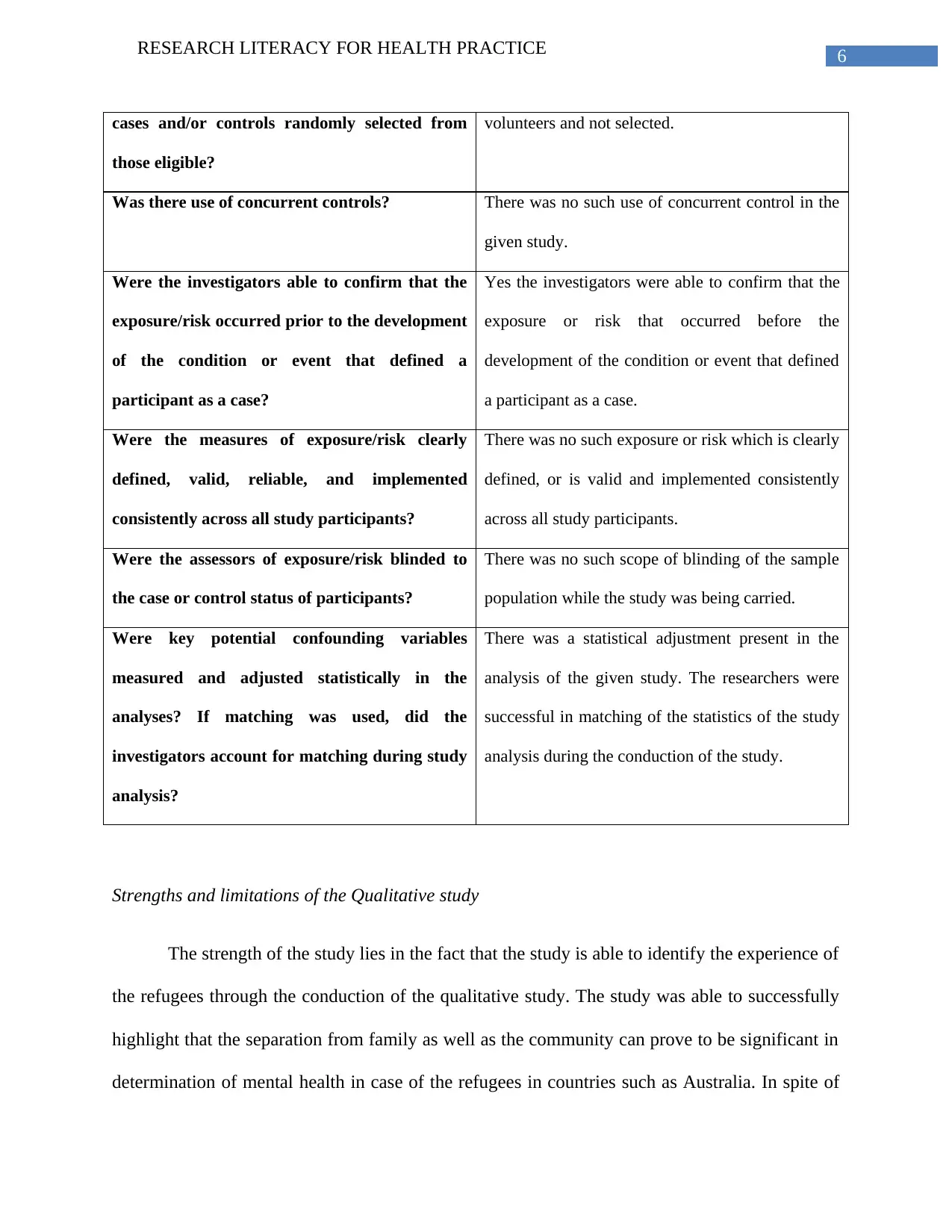
6RESEARCH LITERACY FOR HEALTH PRACTICE
cases and/or controls randomly selected from
those eligible?
volunteers and not selected.
Was there use of concurrent controls? There was no such use of concurrent control in the
given study.
Were the investigators able to confirm that the
exposure/risk occurred prior to the development
of the condition or event that defined a
participant as a case?
Yes the investigators were able to confirm that the
exposure or risk that occurred before the
development of the condition or event that defined
a participant as a case.
Were the measures of exposure/risk clearly
defined, valid, reliable, and implemented
consistently across all study participants?
There was no such exposure or risk which is clearly
defined, or is valid and implemented consistently
across all study participants.
Were the assessors of exposure/risk blinded to
the case or control status of participants?
There was no such scope of blinding of the sample
population while the study was being carried.
Were key potential confounding variables
measured and adjusted statistically in the
analyses? If matching was used, did the
investigators account for matching during study
analysis?
There was a statistical adjustment present in the
analysis of the given study. The researchers were
successful in matching of the statistics of the study
analysis during the conduction of the study.
Strengths and limitations of the Qualitative study
The strength of the study lies in the fact that the study is able to identify the experience of
the refugees through the conduction of the qualitative study. The study was able to successfully
highlight that the separation from family as well as the community can prove to be significant in
determination of mental health in case of the refugees in countries such as Australia. In spite of
cases and/or controls randomly selected from
those eligible?
volunteers and not selected.
Was there use of concurrent controls? There was no such use of concurrent control in the
given study.
Were the investigators able to confirm that the
exposure/risk occurred prior to the development
of the condition or event that defined a
participant as a case?
Yes the investigators were able to confirm that the
exposure or risk that occurred before the
development of the condition or event that defined
a participant as a case.
Were the measures of exposure/risk clearly
defined, valid, reliable, and implemented
consistently across all study participants?
There was no such exposure or risk which is clearly
defined, or is valid and implemented consistently
across all study participants.
Were the assessors of exposure/risk blinded to
the case or control status of participants?
There was no such scope of blinding of the sample
population while the study was being carried.
Were key potential confounding variables
measured and adjusted statistically in the
analyses? If matching was used, did the
investigators account for matching during study
analysis?
There was a statistical adjustment present in the
analysis of the given study. The researchers were
successful in matching of the statistics of the study
analysis during the conduction of the study.
Strengths and limitations of the Qualitative study
The strength of the study lies in the fact that the study is able to identify the experience of
the refugees through the conduction of the qualitative study. The study was able to successfully
highlight that the separation from family as well as the community can prove to be significant in
determination of mental health in case of the refugees in countries such as Australia. In spite of
Paraphrase This Document
Need a fresh take? Get an instant paraphrase of this document with our AI Paraphraser
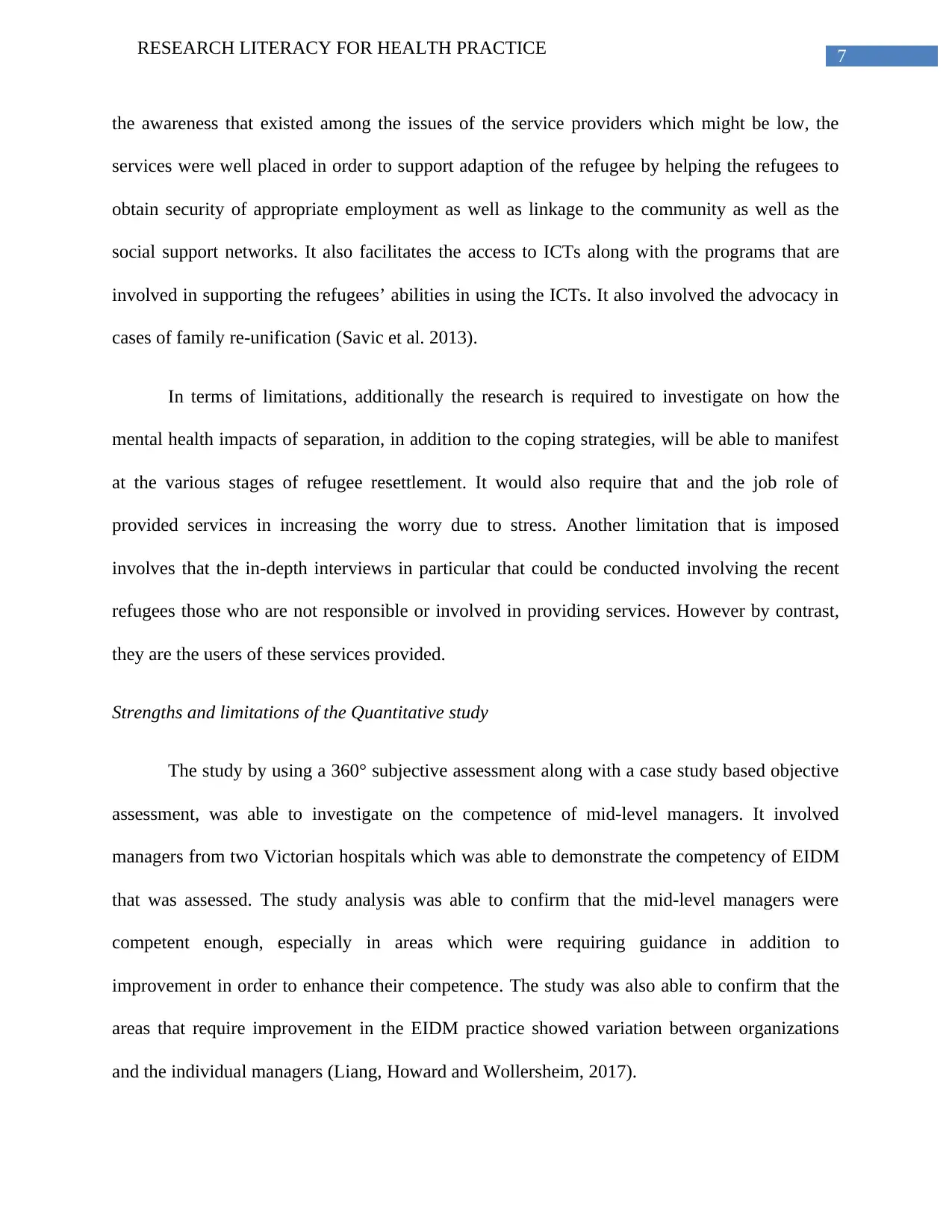
7RESEARCH LITERACY FOR HEALTH PRACTICE
the awareness that existed among the issues of the service providers which might be low, the
services were well placed in order to support adaption of the refugee by helping the refugees to
obtain security of appropriate employment as well as linkage to the community as well as the
social support networks. It also facilitates the access to ICTs along with the programs that are
involved in supporting the refugees’ abilities in using the ICTs. It also involved the advocacy in
cases of family re-unification (Savic et al. 2013).
In terms of limitations, additionally the research is required to investigate on how the
mental health impacts of separation, in addition to the coping strategies, will be able to manifest
at the various stages of refugee resettlement. It would also require that and the job role of
provided services in increasing the worry due to stress. Another limitation that is imposed
involves that the in-depth interviews in particular that could be conducted involving the recent
refugees those who are not responsible or involved in providing services. However by contrast,
they are the users of these services provided.
Strengths and limitations of the Quantitative study
The study by using a 360° subjective assessment along with a case study based objective
assessment, was able to investigate on the competence of mid-level managers. It involved
managers from two Victorian hospitals which was able to demonstrate the competency of EIDM
that was assessed. The study analysis was able to confirm that the mid-level managers were
competent enough, especially in areas which were requiring guidance in addition to
improvement in order to enhance their competence. The study was also able to confirm that the
areas that require improvement in the EIDM practice showed variation between organizations
and the individual managers (Liang, Howard and Wollersheim, 2017).
the awareness that existed among the issues of the service providers which might be low, the
services were well placed in order to support adaption of the refugee by helping the refugees to
obtain security of appropriate employment as well as linkage to the community as well as the
social support networks. It also facilitates the access to ICTs along with the programs that are
involved in supporting the refugees’ abilities in using the ICTs. It also involved the advocacy in
cases of family re-unification (Savic et al. 2013).
In terms of limitations, additionally the research is required to investigate on how the
mental health impacts of separation, in addition to the coping strategies, will be able to manifest
at the various stages of refugee resettlement. It would also require that and the job role of
provided services in increasing the worry due to stress. Another limitation that is imposed
involves that the in-depth interviews in particular that could be conducted involving the recent
refugees those who are not responsible or involved in providing services. However by contrast,
they are the users of these services provided.
Strengths and limitations of the Quantitative study
The study by using a 360° subjective assessment along with a case study based objective
assessment, was able to investigate on the competence of mid-level managers. It involved
managers from two Victorian hospitals which was able to demonstrate the competency of EIDM
that was assessed. The study analysis was able to confirm that the mid-level managers were
competent enough, especially in areas which were requiring guidance in addition to
improvement in order to enhance their competence. The study was also able to confirm that the
areas that require improvement in the EIDM practice showed variation between organizations
and the individual managers (Liang, Howard and Wollersheim, 2017).
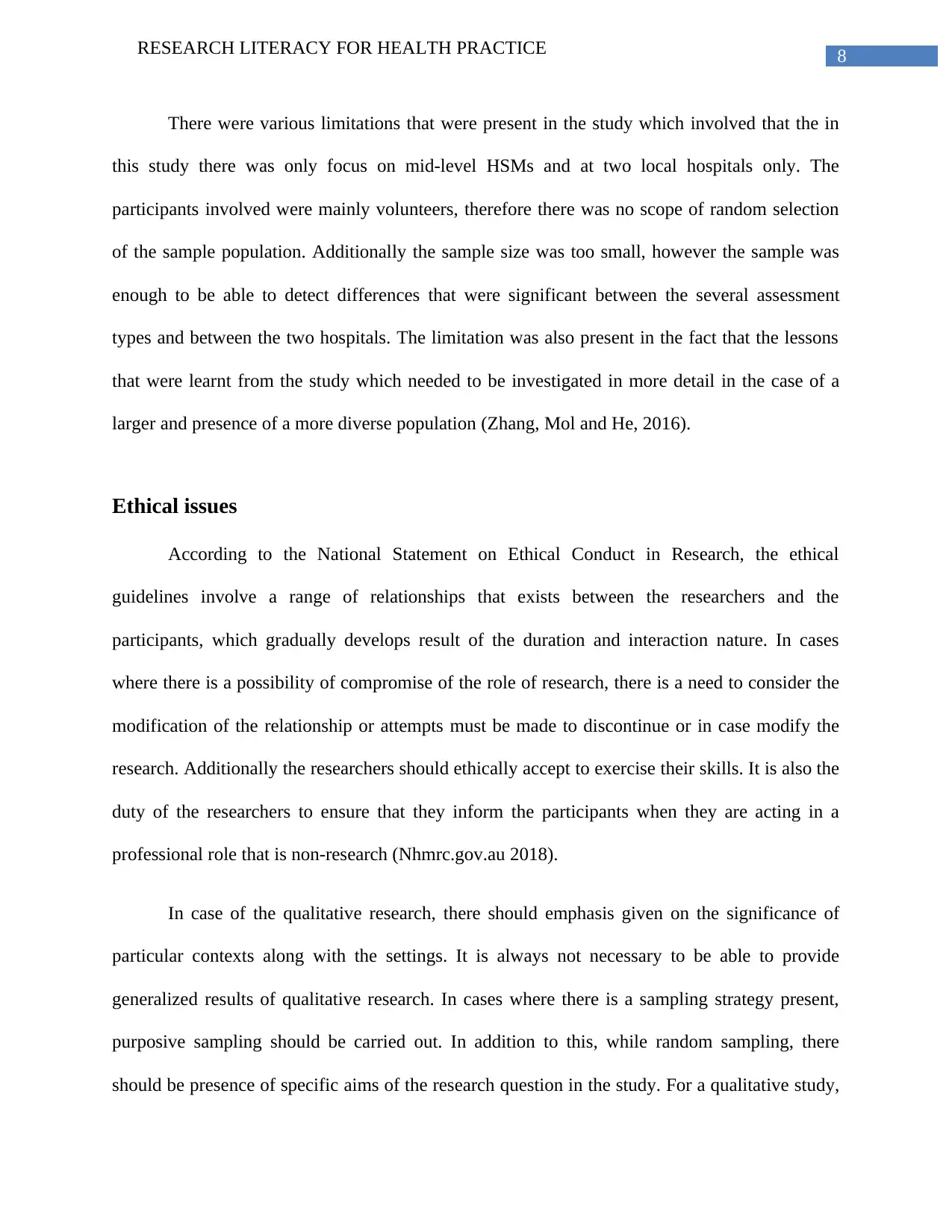
8RESEARCH LITERACY FOR HEALTH PRACTICE
There were various limitations that were present in the study which involved that the in
this study there was only focus on mid-level HSMs and at two local hospitals only. The
participants involved were mainly volunteers, therefore there was no scope of random selection
of the sample population. Additionally the sample size was too small, however the sample was
enough to be able to detect differences that were significant between the several assessment
types and between the two hospitals. The limitation was also present in the fact that the lessons
that were learnt from the study which needed to be investigated in more detail in the case of a
larger and presence of a more diverse population (Zhang, Mol and He, 2016).
Ethical issues
According to the National Statement on Ethical Conduct in Research, the ethical
guidelines involve a range of relationships that exists between the researchers and the
participants, which gradually develops result of the duration and interaction nature. In cases
where there is a possibility of compromise of the role of research, there is a need to consider the
modification of the relationship or attempts must be made to discontinue or in case modify the
research. Additionally the researchers should ethically accept to exercise their skills. It is also the
duty of the researchers to ensure that they inform the participants when they are acting in a
professional role that is non-research (Nhmrc.gov.au 2018).
In case of the qualitative research, there should emphasis given on the significance of
particular contexts along with the settings. It is always not necessary to be able to provide
generalized results of qualitative research. In cases where there is a sampling strategy present,
purposive sampling should be carried out. In addition to this, while random sampling, there
should be presence of specific aims of the research question in the study. For a qualitative study,
There were various limitations that were present in the study which involved that the in
this study there was only focus on mid-level HSMs and at two local hospitals only. The
participants involved were mainly volunteers, therefore there was no scope of random selection
of the sample population. Additionally the sample size was too small, however the sample was
enough to be able to detect differences that were significant between the several assessment
types and between the two hospitals. The limitation was also present in the fact that the lessons
that were learnt from the study which needed to be investigated in more detail in the case of a
larger and presence of a more diverse population (Zhang, Mol and He, 2016).
Ethical issues
According to the National Statement on Ethical Conduct in Research, the ethical
guidelines involve a range of relationships that exists between the researchers and the
participants, which gradually develops result of the duration and interaction nature. In cases
where there is a possibility of compromise of the role of research, there is a need to consider the
modification of the relationship or attempts must be made to discontinue or in case modify the
research. Additionally the researchers should ethically accept to exercise their skills. It is also the
duty of the researchers to ensure that they inform the participants when they are acting in a
professional role that is non-research (Nhmrc.gov.au 2018).
In case of the qualitative research, there should emphasis given on the significance of
particular contexts along with the settings. It is always not necessary to be able to provide
generalized results of qualitative research. In cases where there is a sampling strategy present,
purposive sampling should be carried out. In addition to this, while random sampling, there
should be presence of specific aims of the research question in the study. For a qualitative study,
⊘ This is a preview!⊘
Do you want full access?
Subscribe today to unlock all pages.

Trusted by 1+ million students worldwide
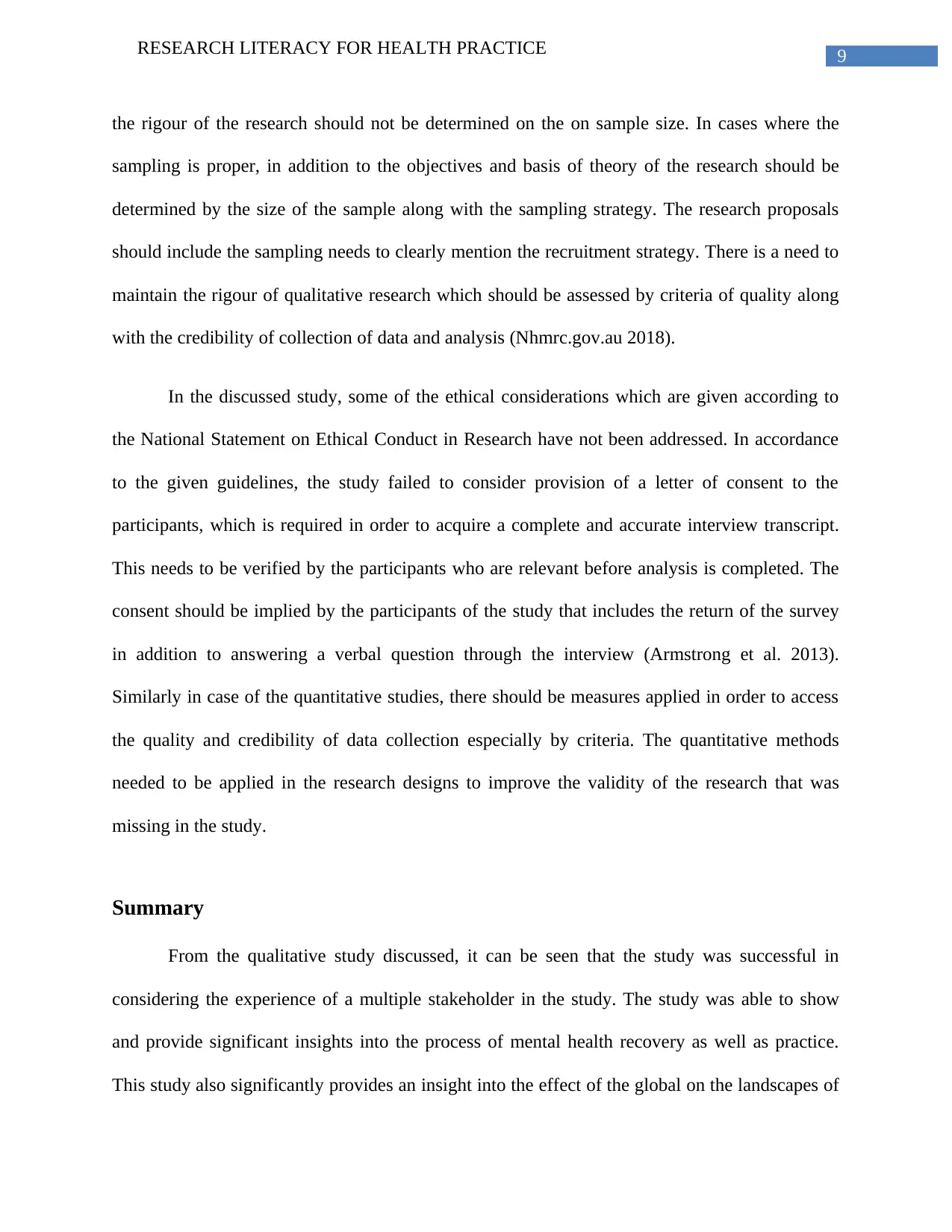
9RESEARCH LITERACY FOR HEALTH PRACTICE
the rigour of the research should not be determined on the on sample size. In cases where the
sampling is proper, in addition to the objectives and basis of theory of the research should be
determined by the size of the sample along with the sampling strategy. The research proposals
should include the sampling needs to clearly mention the recruitment strategy. There is a need to
maintain the rigour of qualitative research which should be assessed by criteria of quality along
with the credibility of collection of data and analysis (Nhmrc.gov.au 2018).
In the discussed study, some of the ethical considerations which are given according to
the National Statement on Ethical Conduct in Research have not been addressed. In accordance
to the given guidelines, the study failed to consider provision of a letter of consent to the
participants, which is required in order to acquire a complete and accurate interview transcript.
This needs to be verified by the participants who are relevant before analysis is completed. The
consent should be implied by the participants of the study that includes the return of the survey
in addition to answering a verbal question through the interview (Armstrong et al. 2013).
Similarly in case of the quantitative studies, there should be measures applied in order to access
the quality and credibility of data collection especially by criteria. The quantitative methods
needed to be applied in the research designs to improve the validity of the research that was
missing in the study.
Summary
From the qualitative study discussed, it can be seen that the study was successful in
considering the experience of a multiple stakeholder in the study. The study was able to show
and provide significant insights into the process of mental health recovery as well as practice.
This study also significantly provides an insight into the effect of the global on the landscapes of
the rigour of the research should not be determined on the on sample size. In cases where the
sampling is proper, in addition to the objectives and basis of theory of the research should be
determined by the size of the sample along with the sampling strategy. The research proposals
should include the sampling needs to clearly mention the recruitment strategy. There is a need to
maintain the rigour of qualitative research which should be assessed by criteria of quality along
with the credibility of collection of data and analysis (Nhmrc.gov.au 2018).
In the discussed study, some of the ethical considerations which are given according to
the National Statement on Ethical Conduct in Research have not been addressed. In accordance
to the given guidelines, the study failed to consider provision of a letter of consent to the
participants, which is required in order to acquire a complete and accurate interview transcript.
This needs to be verified by the participants who are relevant before analysis is completed. The
consent should be implied by the participants of the study that includes the return of the survey
in addition to answering a verbal question through the interview (Armstrong et al. 2013).
Similarly in case of the quantitative studies, there should be measures applied in order to access
the quality and credibility of data collection especially by criteria. The quantitative methods
needed to be applied in the research designs to improve the validity of the research that was
missing in the study.
Summary
From the qualitative study discussed, it can be seen that the study was successful in
considering the experience of a multiple stakeholder in the study. The study was able to show
and provide significant insights into the process of mental health recovery as well as practice.
This study also significantly provides an insight into the effect of the global on the landscapes of
Paraphrase This Document
Need a fresh take? Get an instant paraphrase of this document with our AI Paraphraser
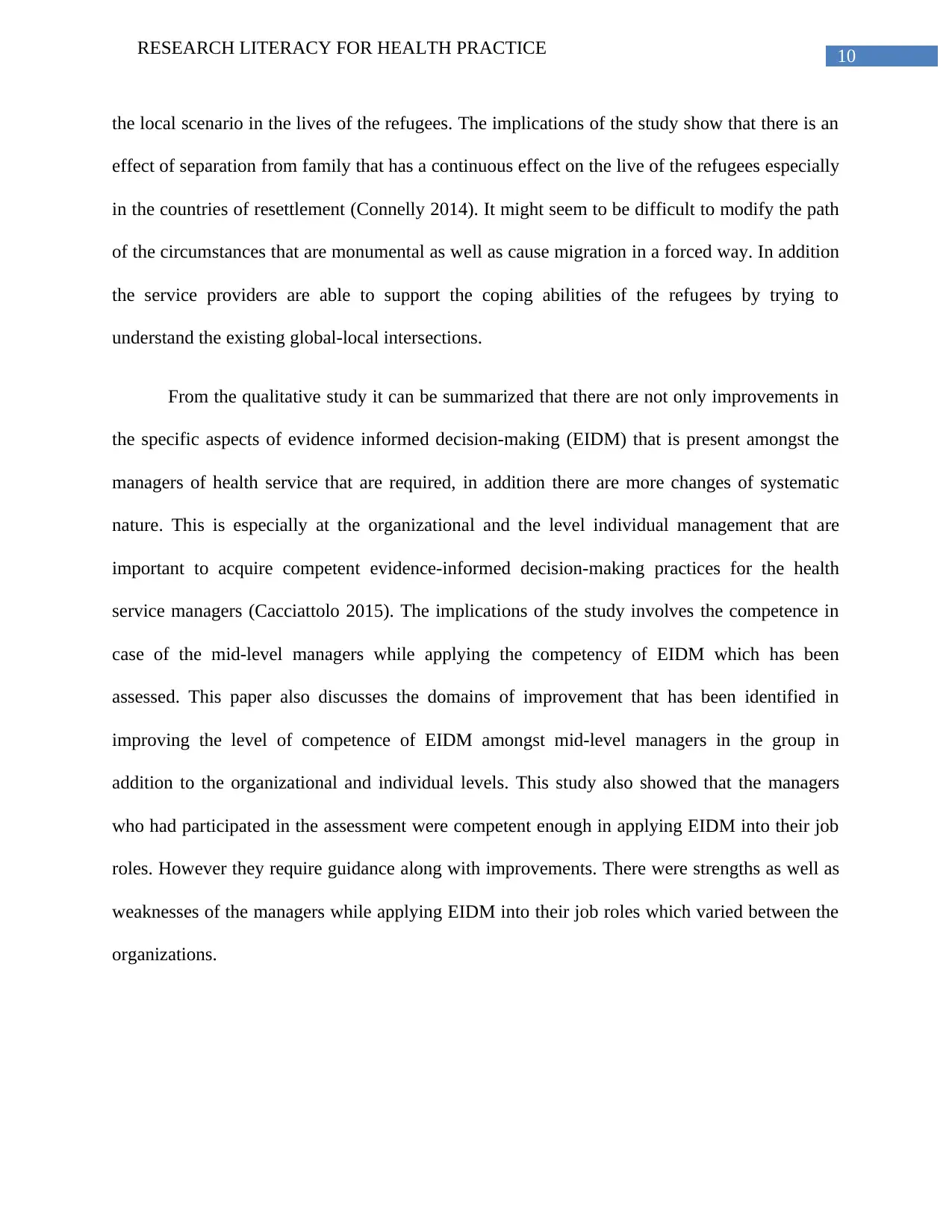
10RESEARCH LITERACY FOR HEALTH PRACTICE
the local scenario in the lives of the refugees. The implications of the study show that there is an
effect of separation from family that has a continuous effect on the live of the refugees especially
in the countries of resettlement (Connelly 2014). It might seem to be difficult to modify the path
of the circumstances that are monumental as well as cause migration in a forced way. In addition
the service providers are able to support the coping abilities of the refugees by trying to
understand the existing global-local intersections.
From the qualitative study it can be summarized that there are not only improvements in
the specific aspects of evidence informed decision-making (EIDM) that is present amongst the
managers of health service that are required, in addition there are more changes of systematic
nature. This is especially at the organizational and the level individual management that are
important to acquire competent evidence-informed decision-making practices for the health
service managers (Cacciattolo 2015). The implications of the study involves the competence in
case of the mid-level managers while applying the competency of EIDM which has been
assessed. This paper also discusses the domains of improvement that has been identified in
improving the level of competence of EIDM amongst mid-level managers in the group in
addition to the organizational and individual levels. This study also showed that the managers
who had participated in the assessment were competent enough in applying EIDM into their job
roles. However they require guidance along with improvements. There were strengths as well as
weaknesses of the managers while applying EIDM into their job roles which varied between the
organizations.
the local scenario in the lives of the refugees. The implications of the study show that there is an
effect of separation from family that has a continuous effect on the live of the refugees especially
in the countries of resettlement (Connelly 2014). It might seem to be difficult to modify the path
of the circumstances that are monumental as well as cause migration in a forced way. In addition
the service providers are able to support the coping abilities of the refugees by trying to
understand the existing global-local intersections.
From the qualitative study it can be summarized that there are not only improvements in
the specific aspects of evidence informed decision-making (EIDM) that is present amongst the
managers of health service that are required, in addition there are more changes of systematic
nature. This is especially at the organizational and the level individual management that are
important to acquire competent evidence-informed decision-making practices for the health
service managers (Cacciattolo 2015). The implications of the study involves the competence in
case of the mid-level managers while applying the competency of EIDM which has been
assessed. This paper also discusses the domains of improvement that has been identified in
improving the level of competence of EIDM amongst mid-level managers in the group in
addition to the organizational and individual levels. This study also showed that the managers
who had participated in the assessment were competent enough in applying EIDM into their job
roles. However they require guidance along with improvements. There were strengths as well as
weaknesses of the managers while applying EIDM into their job roles which varied between the
organizations.
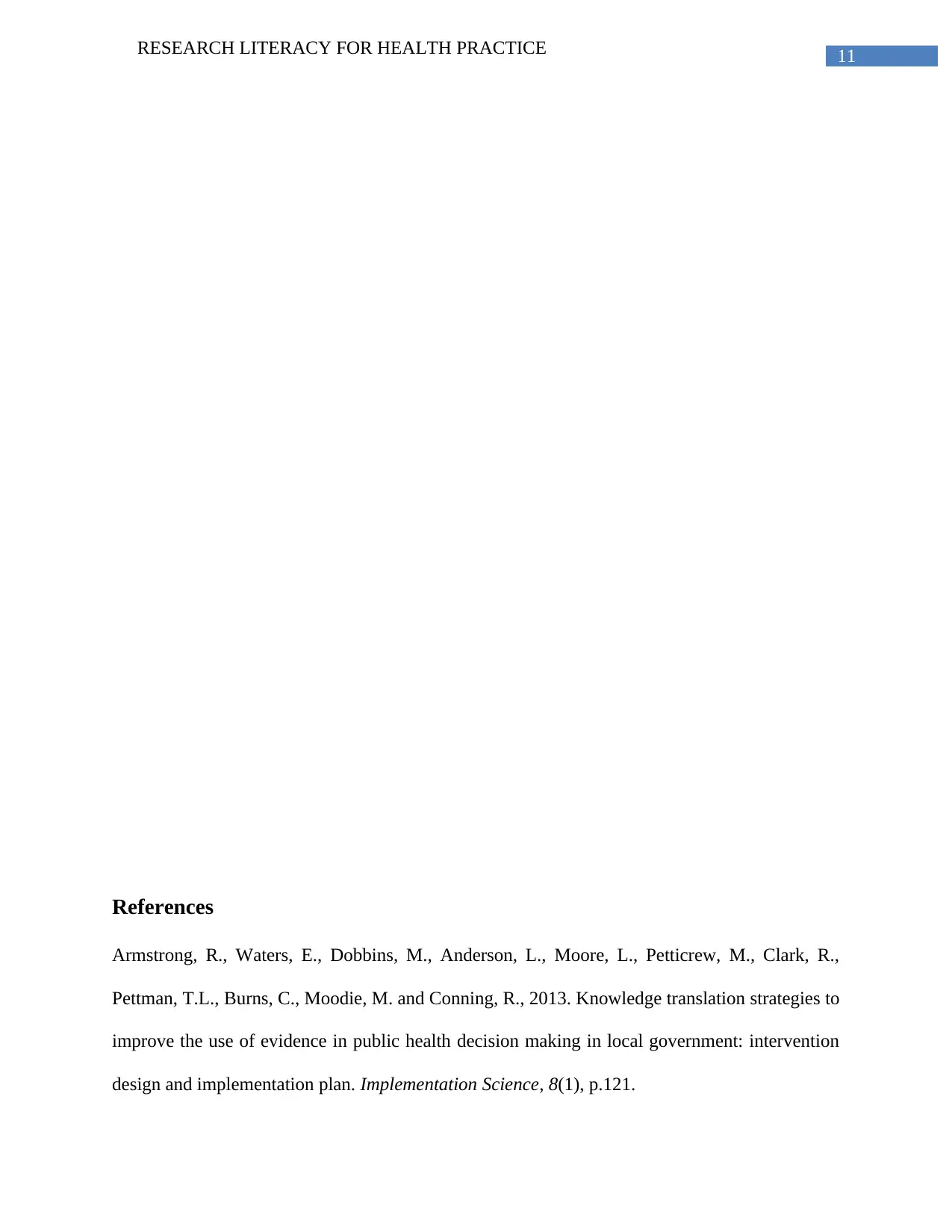
11RESEARCH LITERACY FOR HEALTH PRACTICE
References
Armstrong, R., Waters, E., Dobbins, M., Anderson, L., Moore, L., Petticrew, M., Clark, R.,
Pettman, T.L., Burns, C., Moodie, M. and Conning, R., 2013. Knowledge translation strategies to
improve the use of evidence in public health decision making in local government: intervention
design and implementation plan. Implementation Science, 8(1), p.121.
References
Armstrong, R., Waters, E., Dobbins, M., Anderson, L., Moore, L., Petticrew, M., Clark, R.,
Pettman, T.L., Burns, C., Moodie, M. and Conning, R., 2013. Knowledge translation strategies to
improve the use of evidence in public health decision making in local government: intervention
design and implementation plan. Implementation Science, 8(1), p.121.
⊘ This is a preview!⊘
Do you want full access?
Subscribe today to unlock all pages.

Trusted by 1+ million students worldwide
1 out of 20
Related Documents
Your All-in-One AI-Powered Toolkit for Academic Success.
+13062052269
info@desklib.com
Available 24*7 on WhatsApp / Email
![[object Object]](/_next/static/media/star-bottom.7253800d.svg)
Unlock your academic potential
Copyright © 2020–2025 A2Z Services. All Rights Reserved. Developed and managed by ZUCOL.





